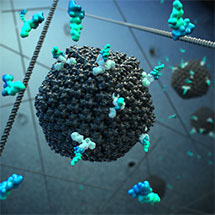
antibodies (white) stuck to its surface
inside the cell. TRIM21 (blue/green)
recognises the antibody leading the
cell to signal that it has become infected
New research, led by Leo James and Will McEwan from the LMB’s PNAC Division, has uncovered a previously unrecognised mechanism of intracellular pathogen detection which may provide a deeper understanding of how antibodies help fight disease and lead to the design of better vaccines and gene therapies.
Earlier research from Leo’s group showed that viruses carry antibodies into cells when they infect them [1]. Once inside, the antibodies trigger a response, led by the TRIM21 protein, which pulls the virus into a disposal system used by the cell to get rid of unwanted material.
The new findings, published in Nature Immunology, show that when TRIM21 detects antibody-bound viruses and bacteria inside a cell it alerts the immune system and prompts changes that make it harder for the pathogens to replicate
As Will explained: “Using experiments on adenovirus, a common human pathogen, we were able to show that, unlike other sensors in cells, TRIM21 doesn’t rely on detecting features that are common to viruses or bacteria in general, such as viral DNA or the sugary coat that surrounds bacteria. This means that cells can potentially detect any intracellular pathogen as long as it is bound by antibodies.”
Leo added: “As some vaccines and gene therapy treatments are delivered using adenovirus ‘vectors’ this research may be helpful in understanding how people who naturally have antibodies against adenovirus may respond to these treatments. It may also reveal why gene therapy vectors sometimes cause dangerous immune reactions. Understanding how antibodies and TRIM21 influence the responses to vectors could lead to better vaccines and safer gene therapies.”
The research team also included Jerry Tam, Ruth Watkinson, Susanna Bidgood and Donna Mallery. The research was funded by the Medical Research Council and the European Research Council.